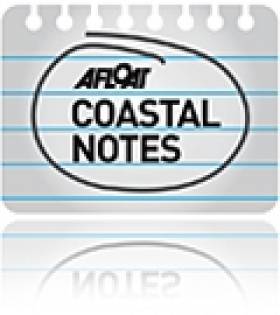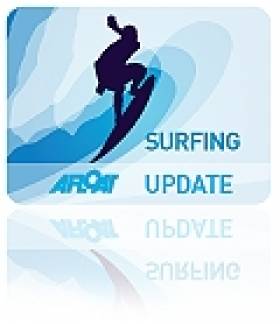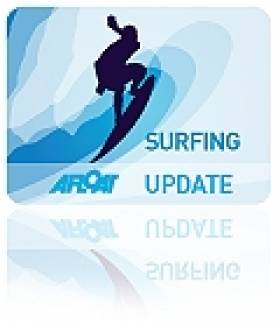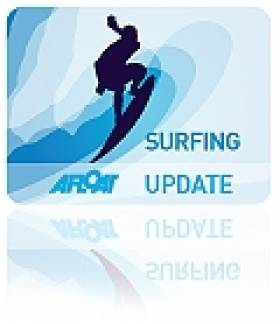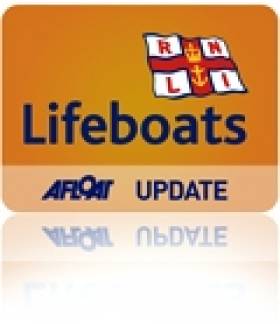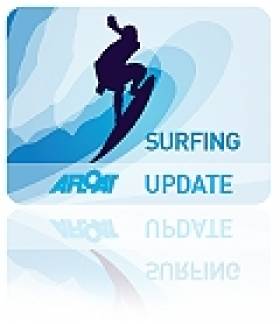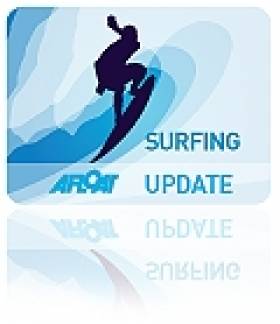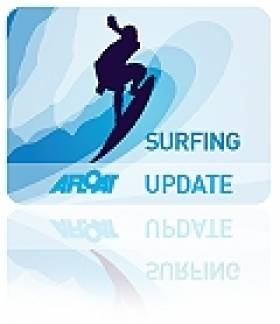Displaying items by tag: Surfing
The Week's Most Impressive Waves From Ireland To Portugal
#Waves - TheJournal.ie has compiled some of the most breathtaking images of the exceptional waves that crashed on the coastlines of Western Europe from Ireland to Britain to France and Portugal over the past week.
The incredible swells saw surfing pros flock in their hundreds to big wave hotspots like Mullaghmore Head in Co Sligo, where regular visitor Andrew Cotton was filmed riding the monsters churned up by the recent Atlantic storms.
Cotty Gets Big Surf On Camera Off Mullaghmore
#Surfing - Devon surfer Andrew Cotton, a regular at Ireland's big wave hotspots, was spoilt for choice as the 'black swell' moved in on the coastlines of Western Europe earlier this week.
But as the video above shows, he plucked for the walls of water off Mullaghmore Head in Co Sligo.
And according to the Daily Telegraph, Cotty was not at all disappointed, catching waves of up to 50 feet charged by the exceptional Atlantic swell - and getting it all on camera for a documentary series on adventure sports web broadcaster EpicTV.
As previously reported on Afloat.ie, the stormy conditions brought surfers in their hundreds to Ireland's west coast to catch the biggest waves going.
#Surfing - Though the recent spate of Atlantic storms have made things difficult for inshore fishermen and devastated coastal areas throughout the country, one contingent that's been welcoming the wind is the world's big wave surfing community.
As The Irish Times reports, 20-metre waves were not uncommon as the Atlantic 'black swell' that swept in with what was dubbed Storm Christine crashed on the shores of Western Europe, and attracted the cream of Ireland's and the world's surfers to the north-west.
Mullaghmore Head, which made the list of Surfer Today's best European big wave surf spots along with Aileens off the Cliffs of Moher, was producing waves on Monday morning described as "too big to tackle" by the Irish Independent.
And first to the Sligo surf was American boarder Kurt Rist, according to Surfer Today, which notes that Belharra in south-west France was another big meeting point for the pros.
The surf at Mullaghmore was even strong enough to snap the board of Irish Surfing Association chair Henry Moore, who got a bloody nose for his troubles yet still sang the praises of the conditions that "put Ireland on the big wave surfing map and that's why so many people have flown in from France, the USA, Germany, Spain and Portugal."
Visitor numbers in Ireland's top west coast surfing haunts were up thanks to the recent Atlantic swell, though at least one local hotelier was caught out as he closed up shop for a fortnight just before the big waves hit - more on that story in the Irish Independent HERE.
#Surfing - Though the storm surges in Lahinch may be too much even for the most experience surfer to handle, big wave chasers will no doubt be champing at the bit to tackle the monsters expected to crash Europe's western shores in the coming days.
Surfing website MagicSeaweed describes the ominous swell due on Monday 6 January - appearing like a black hole on the weather map - as "a step into the unknown" as it comes as a single solid system rather than a chain of multiple cores, set to "deliver huge surf to the whole of west facing Europe and North Africa".
One of those who's surely itching to hit the surf at Mullaghmore Head in Co Sligo is photographer Christian McLeod, who tells the Irish Independent about the "huge thrill" he gets from capturing his breathtaking images from the heart of the action.
Elsewhere in Europe, Portugal is directly in the swell's path, and looks primed to provide some giant waves - possibly even to beat the record-breaking Nazare monster surfed by Irish-American waverider Garret McNamara two years ago.
Kilmore Quay Lifeboat In Christmas Day Surfer Rescue
#RNLI - Kilmore Quay RNLI volunteers had a Christmas Day call-out last week when a surfer got into difficulties just before 4pm.
The man had been surfing at the Burrow Shore off the Memorial Garden to the west of the Co Wexford lifeboat station when he drifted towards the rocky end of the beach, where it would have been dangerous for him to come ashore.
Weather conditions were good at the time, with a light north-westerly breeze with an on-shore swell, good visibility and overcast sky - so the lifeboat crew had no problems responding swiftly, taking the lifeboat’s Y-boat to recover the surfer and his board.
No medical assistance was required and the surfer and his board were landed safely back at the marina.
The Kilmore Quay surfer was just one of hundreds who took to the wintry waters around the coast as Christmas Day saw an array of special events nationwide, from surfing in Strandhill to swimming in Sandycove.
As the Irish Independent reports, locals at Banna Beach in Co Kerry were treated to the incredible sight of 300 people running into the freezing Atlantic in a charity challenge for the local sea rescue unit.
And in Dublin, the traditional Forty Foot plunge brought out its regular contingent of hardy souls.
McCarthy Swaps Surfing For Spirituality
#Surfing - To most people he's probably best known for that iconic AIB television advert, riding the giant waves at Aileen's off the Cliffs of Moher.
But to the surfing community in Ireland and beyond, John McCarthy is regarded as a pioneer of the sport on these shores.
The three-time former Irish senior champion was one of the first to discover and surf that Co Clare giant, and cement Ireland's status as a go-to destination for any wave rider worth their salt.
Today, however, McCarthy is a changed man, as he tells The Irish Post how he found religion and left behind the "egotistical" trappings of surfing culture for a life of greater meaning and purpose for himself beyond the allure of firsts and championship titles.
The Irish Post has much more on the story HERE.
Pre-Christmas Present For Surfers On Ireland's West Coast
#Surfing - Surfers in the West of Ireland will be on standby this week as the latest weather forecasts show a significant swell heading our way across the Atlantic.
According to Surf-Forecast.com, the coastline is already set to experience wave heights of 5 metres or more this afternoon (Sunday 15 December).
But the best may be yet to come, with swells expected to nearly double that height by Thursday (19 December).
And the big wave bounty looks to continue into the following week, providing plenty of opportunity for Ireland's swellseekers to catch a monster before Christmas!
Peter Conroy Latest To Join Northcore Surfing Stable
#Surfing - Irish big wave rider Peter Conroy is the latest addition to the Northcore surfing team.
A relatively late starter in surfing at the age of 16, the Clare native had a solid background in competitive swimming and lifeguarding to build upon
That meant he was well prepared for the heavy surf off Ireland's West Coast, where he keeps a rigorous fitness and training regimen, including his chairmanship of the Irish Surf Rescue Club - organisers of the annual Tow-In Surf Session.
This summer he celebrated his nomination for the 'tube of the year' gong in the Billabong XXL Big Wave Awards.
And now he's a part of Northcore's surfing squad for the UK and Ireland, alongside fellow Irish riders Conor Maguire - who joined two years ago - and team ambassador Richie Fitzgerald.
Conroy said of joining the team: "I'm very excited to work with the Northcore crew for future projects and pushing my limits further with the help of their excellent products."
Northcore's spokesperson added: "We are really pleased to welcome Peter to our team. He's a well respected, talented surfer with a wealth of big wave surfing experience and skills.
"He charges the biggest, meanest waves out there amongst some of the worlds very best as his nomination for XXL Ride of the Year testifies! It's an honour to welcome Peter to Northcore."
Bundoran Named One Of 'World's Coolest Surfing Towns'
#Surfing - When it comes to the world's coolest surfing destinations, Bundoran makes the grade yet again - according to Travel+Leisure magazine.
Nearly 18 months after the Donegal location was named one of the best surfing towns in the world by National Geographic, the big wave hotspot - site of the deciding leg in the 2012 Irish Championships surfing tour - has been included in Travel+Leisure's list of the 'World's Coolest Surf Towns'.
Indeed, Bundoran's listed along with 15 other renowned surf pilgrimage sites such as Encinitas in California, Australia's Byron Bay, Jeffreys Bay in South Africa and Hawaii's Paia and Haleiwa.
"Passion for pubs, music, and surf culture collides" in Bundoran, the magazine says, highlighting the town's three-time hosting of the European Surfing Championships and reputation for rock-band jams "into the wee hours at bars like Chasin' Bull", not to mention the "lively conservation" at Brennan's Criterion, an institution for more than a century.
The accolade for Bundoran comes just a few months after Mullaghmore Head, a little further along the northwest coast in Co Sligo, was named one of USA Today's 'World's Most Surprising Surf Spots'.
And it will surely be good news for Irish tourism chiefs who've recently launched a drive to attract more surfing enthusiasts to our shores, particularly over the quality winter surfing season.
Irish Surfer In Running For 'Worst Wipeout' Award
#Surfing - Bundoran-based Peter Craig currently tops the voting among six unlucky surfing enthusiasts shortlisted for Surfer magazine's ignoble 'Worst Wipeout' award, as BreakingNews.ie reports.
When the recent giant swells hit Ireland's northwest coast, veteran waverider Craig was out there in the surf with the best of them.
But as the video clip above shows, he ended up a victim of the wall of water for which Mullaghmore Head's become famous.
However, the Derryman takes it all in his stride, describing the wipeout as "par for the course" for any hardened wave hound.
"I'd love to win [the award]," he adds, "but wouldn't be able to afford to get to Hawaii to pick it up."
The Surfer Poll awards will be webcast live on Friday 6 December.
Below is a video featuring more action from Mullaghmore Head over Halloween:

